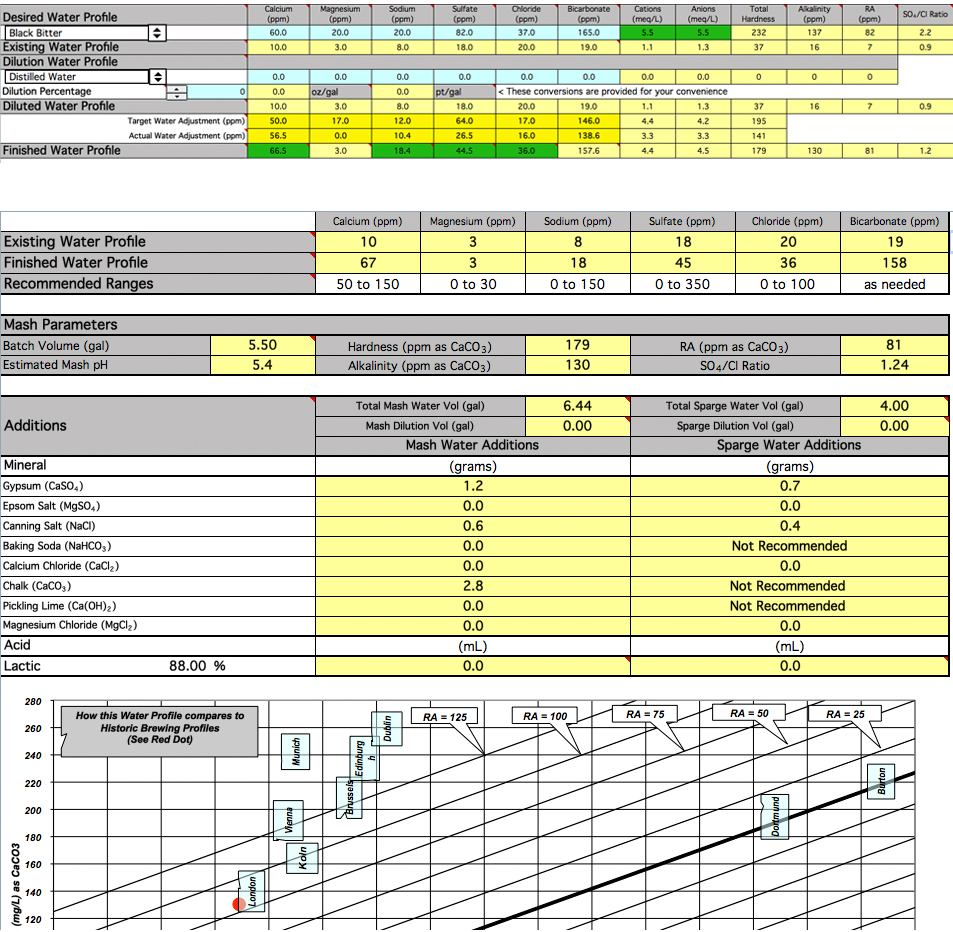BrewDrinkRepeat
Well-Known Member
Screenshots of Bru'n Water and the recipe below.
Hoping to get a sanity check on my water adjustments for the rye robust porter I plan to brew on Sunday. I'm still learning about water adjustments, but this seems to make sense to me -- I'm not adding a ton of salts, the additions I'm making should bring me to my desired targets, and my calculated mash pH is 5.4. The only thing I didn't quite hit was the Sulfate : Chloride ratio, but given the style I think 1.2 will be OK.
Anyone see anything amiss here?
Thanks in advance!
BDR

12-B Robust Porter
Size: 5.5 gal
Efficiency: 64.4%
Attenuation: 75.0%
Calories: 309.64 kcal per 16.0 fl oz
Original Gravity: 1.069 (1.048 - 1.065)
Terminal Gravity: 1.017 (1.012 - 1.016)
Color: 28.97 (22.0 - 35.0)
Alcohol: 6.87% (4.8% - 6.5%)
Bitterness: 38.1 (25.0 - 50.0)
Ingredients:
11.75 lb (67.5%) 2-Row Brewers Malt - added during mash
1.5 lb (8.6%) Munich 10L Malt - added during mash
1 lb (5.7%) Caramel Malt 40L - added during mash
.75 lb (4.3%) Chocolate Malt - added during mash
.5* lb (2.9%) American Black Patent - added during mash
1.5 lb (8.6%) Rye Flaked - added during mash
.4 lb (2.3%) Acidulated Malt - added during mash
2 oz (57.1%) East Kent Goldings (5.0%) - added during boil, boiled 60*m
.75 oz (21.4%) Fuggle (4.6%) - added during boil, boiled 15*m
.75 oz (21.4%) East Kent Goldings (5.0%) - added during boil
1 tsp Wyeast Nutrient - added during boil, boiled 10*m
1 ea Whirlfloc Tablets (Irish moss) - added during boil, boiled 10*m
1 ea Wyeast 1056 American Ale™
1 ea Clarity-Ferm (10ml) - added dry to primary fermenter
Mash @ 153ºF
Ferment @ 67ºF
Hoping to get a sanity check on my water adjustments for the rye robust porter I plan to brew on Sunday. I'm still learning about water adjustments, but this seems to make sense to me -- I'm not adding a ton of salts, the additions I'm making should bring me to my desired targets, and my calculated mash pH is 5.4. The only thing I didn't quite hit was the Sulfate : Chloride ratio, but given the style I think 1.2 will be OK.
Anyone see anything amiss here?
Thanks in advance!
BDR

12-B Robust Porter
Size: 5.5 gal
Efficiency: 64.4%
Attenuation: 75.0%
Calories: 309.64 kcal per 16.0 fl oz
Original Gravity: 1.069 (1.048 - 1.065)
Terminal Gravity: 1.017 (1.012 - 1.016)
Color: 28.97 (22.0 - 35.0)
Alcohol: 6.87% (4.8% - 6.5%)
Bitterness: 38.1 (25.0 - 50.0)
Ingredients:
11.75 lb (67.5%) 2-Row Brewers Malt - added during mash
1.5 lb (8.6%) Munich 10L Malt - added during mash
1 lb (5.7%) Caramel Malt 40L - added during mash
.75 lb (4.3%) Chocolate Malt - added during mash
.5* lb (2.9%) American Black Patent - added during mash
1.5 lb (8.6%) Rye Flaked - added during mash
.4 lb (2.3%) Acidulated Malt - added during mash
2 oz (57.1%) East Kent Goldings (5.0%) - added during boil, boiled 60*m
.75 oz (21.4%) Fuggle (4.6%) - added during boil, boiled 15*m
.75 oz (21.4%) East Kent Goldings (5.0%) - added during boil
1 tsp Wyeast Nutrient - added during boil, boiled 10*m
1 ea Whirlfloc Tablets (Irish moss) - added during boil, boiled 10*m
1 ea Wyeast 1056 American Ale™
1 ea Clarity-Ferm (10ml) - added dry to primary fermenter
Mash @ 153ºF
Ferment @ 67ºF


 )
)